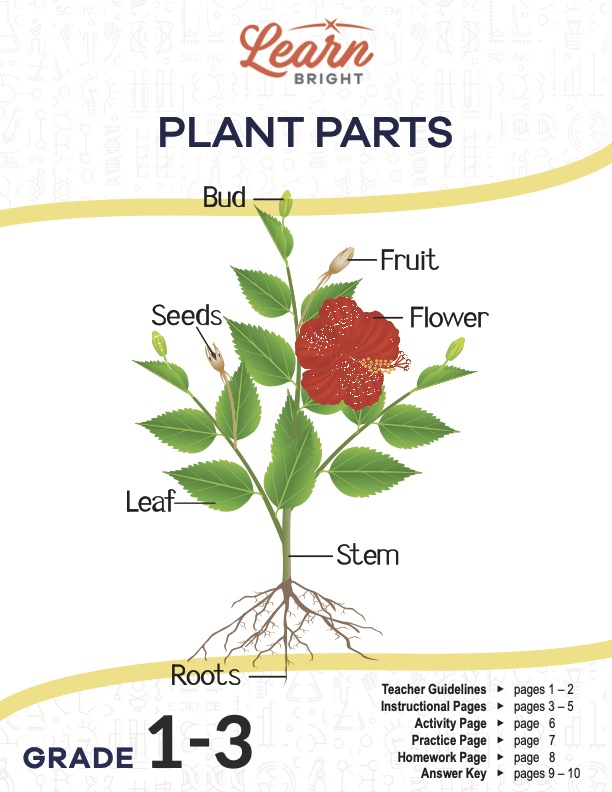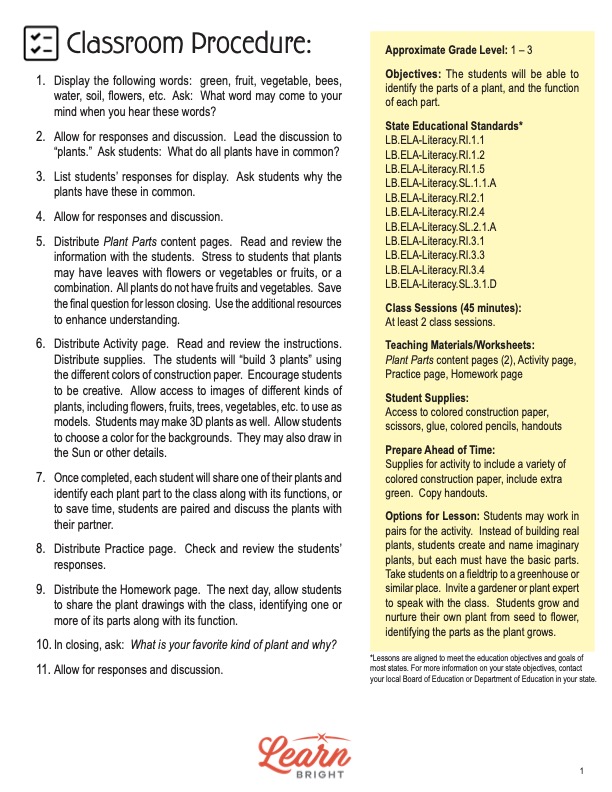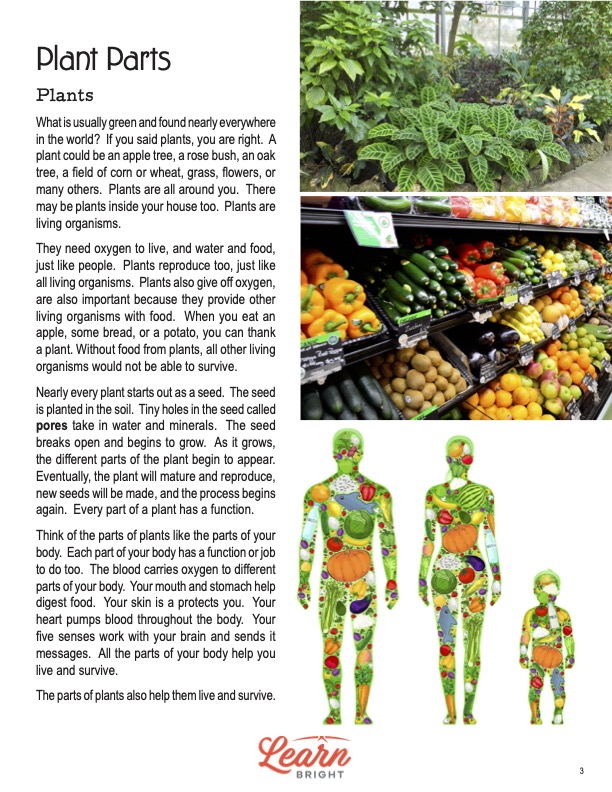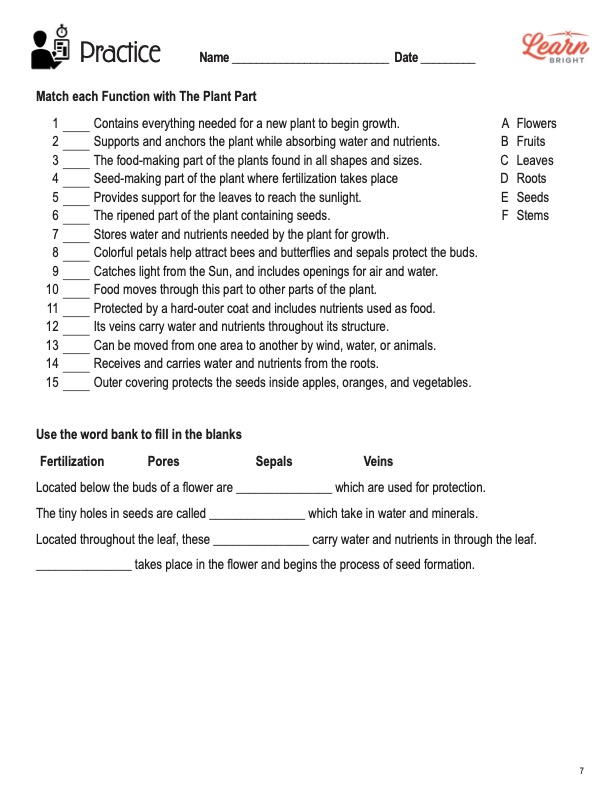Description
What our Plant Parts lesson plan includes
Lesson Objectives and Overview: Plants Parts teaches students about the basic elements of a plant: root, stem, leaves, flowers, fruits, and seeds. Students will learn to identify these different components and will be able to describe their functions. They will discover that each one plays an important role in helping the plant survive. This lesson is for students in 1st grade, 2nd grade, and 3rd grade.
Classroom Procedure
Every lesson plan provides you with a classroom procedure page that outlines a step-by-step guide to follow. You do not have to follow the guide exactly. The guide helps you organize the lesson and details when to hand out worksheets. It also lists information in the yellow box that you might find useful. You will find the lesson objectives, state standards, and number of class sessions the lesson should take to complete in this area. In addition, it describes the supplies you will need as well as what and how you need to prepare beforehand. This lesson requires construction paper in different colors, scissors, and colored pencils.
Options for Lesson
In the “Options for Lesson” section, you will find several suggestions for additional activities or alternatives for the lesson. One suggestion is to have students work in pairs for the activity, for instance. Instead of having your students build real plants, they can make up their own. Another suggestion is to plan a field trip to a greenhouse or garden where students can find many different plants to study. You could also invite a gardener or plant expert to come speak to the students. One more optional addition to this lesson is to have students grow plants from seed to flower and identify the different parts as they grow.
Teacher Notes
The teacher notes page provides an extra paragraph of guidance for the lesson. It mentions that taking the students outside could be very helpful for the lesson, as it would provide them with a more hands-on experience. It also suggests delivering the lesson in conjunction with others that relate to plants or flowers. Use the blank lines to write any other notes you might have before you teach your students.
PLANT PARTS LESSON PLAN CONTENT PAGES
Introduction
The Plant Parts lesson plan contains three pages of content. The first page introduces students to plants and what they require to survive. Students will discover that plants surround them in the form of flowers, fruit trees, grass, and so much more. They will learn that plants need oxygen, water, and food to survive, just as humans do. They give off oxygen and provide animals and humans with a source of food. In fact, if plants did not exist, all other living organisms would fail to survive on their own.
Students will learn some basic information on how plants grow. Nearly every plant starts out as a seed of some kind. When someone plants a seed in soil, tiny holes in the seed (pores) absorb water and minerals. The seed eventually breaks open and begins to grow. As it grows, different parts of the plant start to appear, such as the stem and leaves. Eventually, the plant will reproduce and start the process over again. Students will learn that every part of a plant has a specific function. The lesson relates this concept to parts of the human body. The hands and feet have different functions, as do the eyes and ears. The mouth and stomach help digest food. The skin protects other parts of the body from certain elements. And the five senses work with the brain to send messages. This concept also applies to plants.
Parts of a Plant
Students will next learn about specific plant parts and their corresponding functions. First, they will learn about roots. The roots support and anchor the plant and absorb water and nutrients that are necessary for growth. They also store sugar and other minerals and carry water and nutrients to other parts. Next, students will learn about stems. The stem receives and carries the water and nutrients from the roots to other areas. The food that the leaves produce moves through the stems to other areas as well. Stems also provide support for the leaves to reach sunlight.
One of the main functions of leaves is to make food. Leaves come in many different shapes and sizes. They catch light and allow air and water to come and go through tiny openings. The veins that connect the leaves to the stem carry water and nutrients throughout the leaf. The next part is flowers. A flower is where seeds form during the fertilization process. Some flowers turn into fruits or vegetables. The colorful petals attract butterflies and bees. Below the flower are sepals, which help protect the buds.
Students will next learn about fruits. Fruits are the part of a plant that contain seeds. The outer covering protects the seeds within (except for strawberries). These also come in many shapes, sizes, and colors. Finally, students will learn about seeds. Seeds contain all the stuff that is necessary for a new plant. They often travel from place to place because of wind, water, or animals.
Key Terms
Here is a list of the vocabulary words students will learn in this lesson plan:
- Pore: a tiny hole in a seed that absorbs water and minerals
- Root: the anchor of a plant that absorbs water and nutrients from the soil
- Stem: the stalk of a plant that helps move water and food throughout the plant
- Leaf: the part of a plant that absorbs sunlight and makes food
- Vein: the line in a leaf that connects to the stem and allows the flow of water and nutrients
- Flower: the seed-making part of a plant
- Fertilization: the process by which a seed forms and grows
- Sepal: the leaflike structures below flower petals that protect the buds
- Fruit: the ripened part of a plant that contains seeds
- Seed: the base structure from which a plant can grow
PLANT PARTS LESSON PLAN WORKSHEETS
The Plant Parts lesson plan includes three worksheets: an activity worksheet, a practice worksheet, and a homework assignment. These worksheets will test students’ knowledge in different ways to help reinforce the concepts they learned about during the lesson. The guidelines of the classroom procedure explain when to hand out each worksheet.
BUILD A PLANT ACTIVITY WORKSHEET
You are welcome to have students work in pairs or groups for the activity if you prefer. For the activity, students will use the provided supplies to build three different plants. They will decide beforehand which ones to build and what they will look like. Each one must include at least four of the six parts they learned about during the lesson. Once they complete the plants, they will label the parts and decorate the background however they wish. The worksheet has three blank boxes for students to use to draw rough drafts before they begin.
PLANT PARTS PRACTICE WORKSHEET
The practice worksheet has two sections. The first section lists 15 function descriptions. Using the six plant parts listed in the word bank, students will match the descriptions to the correct term. Students will use each term up to three times. For the second section, students will fill in the blanks in four sentences using the terms in the word bank.
LABEL AND SKETCH HOMEWORK ASSIGNMENT
Similar to the practice worksheet, the homework assignment has two sections. The first section requires students to label the different parts of a plant. For the second section, students will find a plant from their yard or neighborhood and sketch it in the blank box at the bottom of the worksheet.
Worksheet Answer Keys
The last two pages of this lesson plan are the answer keys for the practice and homework worksheets. The activity does not have an answer key, but you may still want to check that students labeled their plants correctly. For the practice worksheet, the answer key marks the correct answers in red for both sections. The first part of the homework answer keys shows the correct labels in red. However, because students’ drawings will all differ, you will need to check those on a student-to-student basis. If you choose to administer the lesson pages to your students via PDF, you will need to save a new file that omits these pages. Otherwise, you can simply print out the applicable pages and keep these as reference for yourself when grading assignments.











